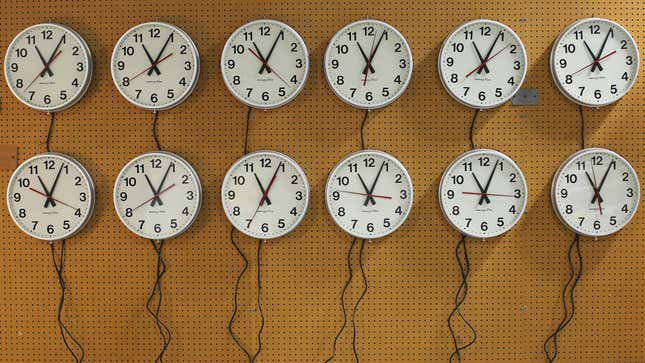Where does the time go?
As we turn the page on yet another year, and another decade (!), it’s only natural to think about the passage of time. Are we really spending it the way we want to? Can we tame it? Get more of it? At least not feel like we have so little of it?
“What defines us in our lives is how we choose to spend our time,” says software engineer and former Facebook executive Tim Campos. He now runs a calendar-management app company so he may be biased—but that doesn’t make him wrong.
This week’s field guide is all about rethinking your relationship with time. It includes simple strategies for structuring your day, an interview with Nir Eyal, author of the 2019 book Indistractable, and a time-saving presentation on the productivity systems and apps that will help you put a new, more efficient routine into action.
In this state of play, we propose three different ways to think about time, each of which can help you be happier and more productive in the new year.
Table of contents
Time is a limited resource | Time is currency and a form of communication | Time is a source of conflict

Time is a limited resource
When your daily priorities are out of sync with your deeper needs and long-term goals, it has consequences, even if you don’t always notice them right away. You can only neglect your most important relationships, your health, or your dreams for so long before they begin to fray. The tension builds, the body deteriorates, the burnout sets in, and then comes the realization that you have devoted too much time to less important pursuits and not enough to what matters.
Wouldn’t it be wiser to think about your time usage proactively, instead of waiting to hit rock bottom?
One way to refresh your thinking about time is to visualize how much of it you have, what you’ve done with it so far, and what more you’d like to do with it. That’s what Campos, the founder of calendar startup Woven, did when he got a life coach 11 years ago.
“This guy had me write down, on a card, when I was born, and he gave me 100 years to live, which seemed a little generous to me since most of the men in my family have died in their 80s,” says Campos. They nonetheless applied the 100-year timeline to other cards representing his different goals, from the professional aspirations he wanted to fulfill to the kind of house he wanted to live in. On each card, they plotted where he was, age-wise, and saw how many years he had left.
Six weeks later, he quit his job at semiconductor equipment maker KLA-Tencor. He was 35 at the time, the youngest chief information officer in the Fortune 500. It was an appealing amount of stature but he didn’t love the work, and he no longer felt he had any time to waste in a job that didn’t make him happy. The cards from the coaching exercise were “a physical representation of [the idea that] you’re not one year old and you don’t have infinite time to get started on what you want to do,” he says. “It created a sense of urgency.”
It also made him realize that it’s important to identify not only what your goals are, but when you want to attain them—“because it would kind of suck to get the house you want to live in on year 82 of your 82 years,” he says.
Things worked out for Campos. A few months after leaving his job, he landed the CIO role at Facebook, where he stayed for six years. He left there in 2016 and co-founded Woven, which is something he says he wanted to do before he was 50 (he’s 46 now). These days, he spends his time in ways that he says are in service to his goals, and he’s content.
“The stereotype with the startup CEO is they plow their life into their startup and ruin their personal lives. I married my high-school sweetheart and it’ll be 30 years in January. I want to make sure I’m available for her. I have two kids, they’re teenagers. I’m very conscious that my time with them is limited, and I appreciate every moment I have with them. So I care about this stuff,” he says. “And I actually feel really good about how I manage time for my personal life and my professional life. I’m not a nine-to-fiver. My company gets all the time that I can give it, but that is not sleep, and that is not my personal time. … We have to be more fluid in [defining] when our professional life starts and stops in order to be successful. But at the same time, we have to allocate time to our personal lives and be there for the people who need us.”
Further reading and a podcast from Quartz:
A simple system helped me to stop obsessing over work and start prioritizing my family
FWD: Thinking, featuring guests who yearned to do something different in their career—and did it (available on Apple Podcast, Google Podcast, Spotify, and Stitcher)

Time is currency, and a form of non-verbal workplace communication
John Geyer, the chief innovation officer at insurance giant MetLife, has simple advice for his fellow innovators: You need buy-in from your company’s business units to support whatever new thing you’re proposing. And to get this buy-in, you’re going to need to set up some meetings with folks in the business units—ideally the ones who are legitimately interested in innovating with you. The catch?
“It can’t be with the most available people. You want the least available people,” Geyer advised in a talk at The Collective, a conference in New York for strategists and innovation executives, hosted in December by CB Insights. The audience laughed; they understood the challenge.
In the workplace, time is an almost imperceptible current of power and influence. Along with title, pay, and sheer charisma, the way we dole out our time (or control other people’s time) communicates stature, whether we intend it to or not.
Who sets the norms for internal emails and instant messages, deciding whether they’re used in the evenings and on weekends, or during people’s vacations? Who decides on meeting times? Is it the lowest-ranking employee in the group, or the highest (and therefore, we presume, the busiest)? How quick or how slow are we to reply to colleagues who need our input to proceed with a project? And what message do we send, inadvertently or otherwise, with the cadence of our response?

Technology has both worsened these power dynamics and tempered them. On the one hand, we now are potentially at the beck and call of our colleagues, bosses, and underlings 24/7, thanks to mobile phones, airplane wifi, and cloud computing. On the other hand, as my Quartz at Work colleague Lila MacLellan has observed, “Meetings used to be places where people were isolated and forced to give their attention to the boss or the group. Now it’s more difficult to monopolize someone’s time since they literally are holding a private channel to the world outside the room. Add to this mix remote workers, who are not in the room at all.” Now, she notes, when “you’re forced into a meeting where you don’t need to be, or where a mansplainer is wasting your time as your phone blows up with notifications from a client, your smartphone is suddenly an equalizer.”
Further reading on Quartz at Work:
Time is a strong but rarely recognized power construct in the workplace

Time is a source of conflict
If you’re the type of person who always eats lunch at 12:30 pm because that’s how you schedule your day, congratulations—the workplace is your oyster. In the West, and increasingly in other regions of the world, businesses run on just this type of “clock time.” We block client calls in advance on our calendars, we conclude meetings at the designated stopping times, and we tend to leave our workstations only when we finally have to get ourselves somewhere else, perhaps a dinner date or aftercare pick-up.
Clock time first became a feature of the workplace in the 1700s, when hourly wage systems took hold. And it quickly proliferated. Here’s my colleague Lila again, explaining the perks and drawbacks of clock-based environments:
The logic of clock time revolutionized assembly lines and would eventually give us Amazon’s insanely calibrated logistics, but clock time itself is totally artificial and it doesn’t work for everyone. Writers need time to let an idea expand and take shape. Artists talk about characters in a play or book slowly revealing themselves, and managers who want to take advantage of creative talent during project work need to take this essential way of being into consideration, says Tamar Avnet, a professor of marketing at Yeshiva University in New York.
If clock time sounds unappealing to you, maybe you’re in the other camp—the one that prefers to run on event time. Those are people who eat lunch when they’re hungry, regardless of what time the clock says; they want to end the meeting when the decision is reached, not when the calendar says it’s over. Much of the world is still run on event time, and as Lila reports, many of the office workers in emerging economies, akin to learning a second language, “acquire an ability to seamlessly move between the event time tempo of family life, and expectations at work.”
Regardless of where you are or whether you consider yourself more of a clock-time person or an event-time person, you probably have less control of your time than you think—which likely reflects both a shortage of purposeful planning on our own part, plus the aforementioned workplace power dynamics.
At Woven, which gets layered over Google calendar and other personal and professional calendar apps, “it’s been amazing to realize that 50% of the time that goes on our calendar gets there just three days in advance or less,” says Campos, whose software has helped manage tens of millions of calendar events. “And 70% gets there in one week or less. That means we’re spending our time reacting. We’re not being proactive, planning to do things.”
Perhaps the most startling statistic of all? On average, Campos says, “60% of the time that’s on our calendar is defined by somebody else.”

Wresting more control over our time generally requires a change in habits—both our own and that of the people around us. Campos recommends blocking out personal time on your calendar, along with time you want to spend doing deep work or active thinking, and the time you might have to spend doing busy work. The team at Quartz at Work recommends writing “user manuals,” in which people can inform their colleagues, managers, or underlings about how to best “operate” them, explaining, for example, how and when they prefer to communicate. Consider both strategies polite ways of setting your professional boundaries and protecting your reserves of your life’s most precious commodity: your time.
Further reading on Quartz:
“Reclaiming my time”: Strategies from a scholar of chronemics, the study of time
